Service Quality Theories Applied in Automobile Sector: Toyota Case
VerifiedAdded on 2023/04/17
|11
|3427
|319
Report
AI Summary
This assignment focuses on the range and scope of theories applied to service quality within the Toyota automobile sector. It defines and explains key terminology such as the Kaizen model, Lean model, and Six Sigma model, detailing their application in improving service quality and reducing waste. The report analyzes characteristics of various areas within the automobile sector, including manufacturing, marketing, and assembling, emphasizing the importance of each in achieving quality. It also provides an analysis of the strengths and differences between quality theories and models, highlighting how each contributes to continuous improvement, waste reduction, and customer satisfaction. The report concludes with recommendations based on issues faced by Toyota, aiming to enhance their service quality through strategic application of these theories. Desklib offers this report along with numerous other resources like past papers and solved assignments to aid students in their studies.
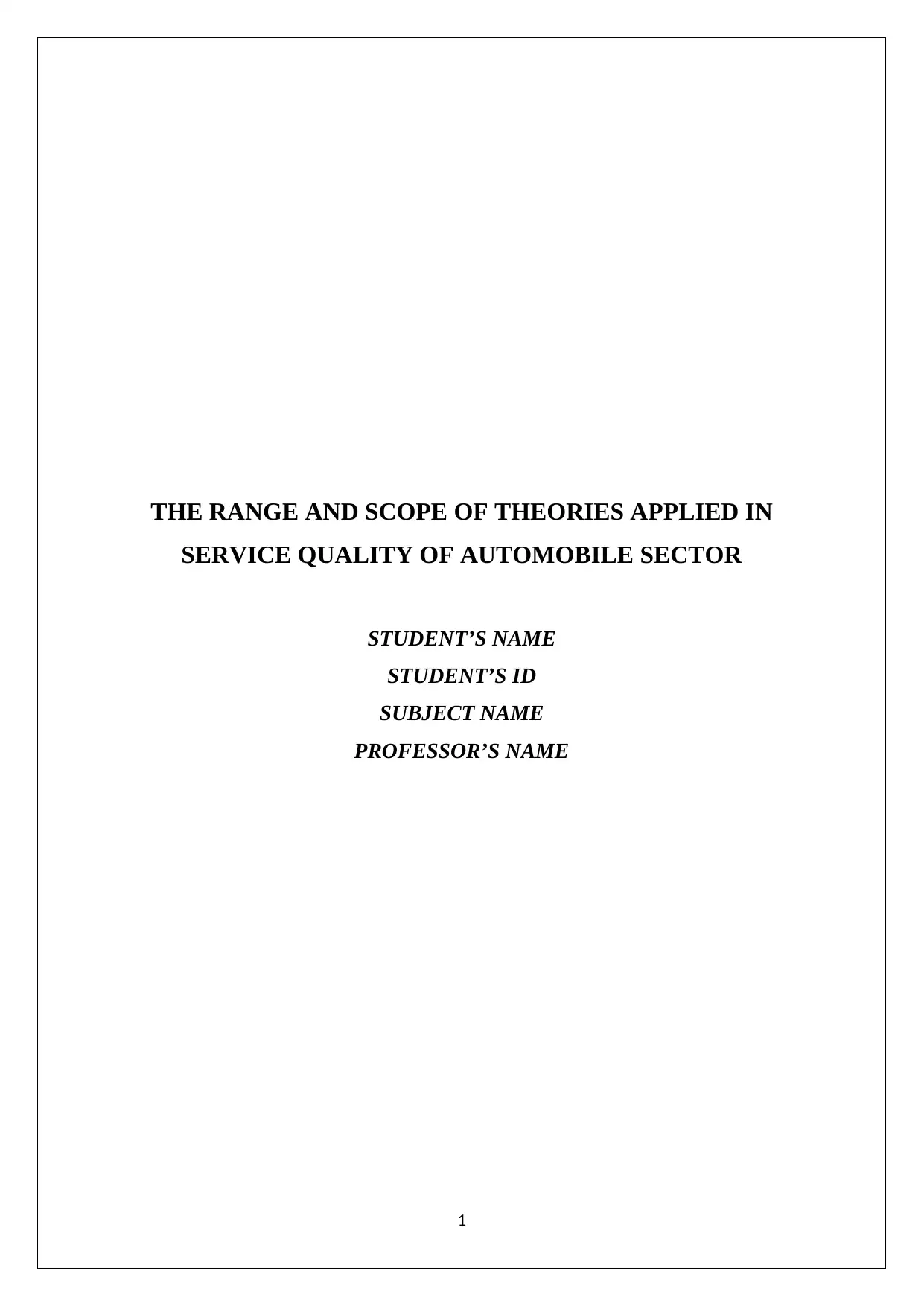
THE RANGE AND SCOPE OF THEORIES APPLIED IN
SERVICE QUALITY OF AUTOMOBILE SECTOR
STUDENT’S NAME
STUDENT’S ID
SUBJECT NAME
PROFESSOR’S NAME
1
SERVICE QUALITY OF AUTOMOBILE SECTOR
STUDENT’S NAME
STUDENT’S ID
SUBJECT NAME
PROFESSOR’S NAME
1
Paraphrase This Document
Need a fresh take? Get an instant paraphrase of this document with our AI Paraphraser
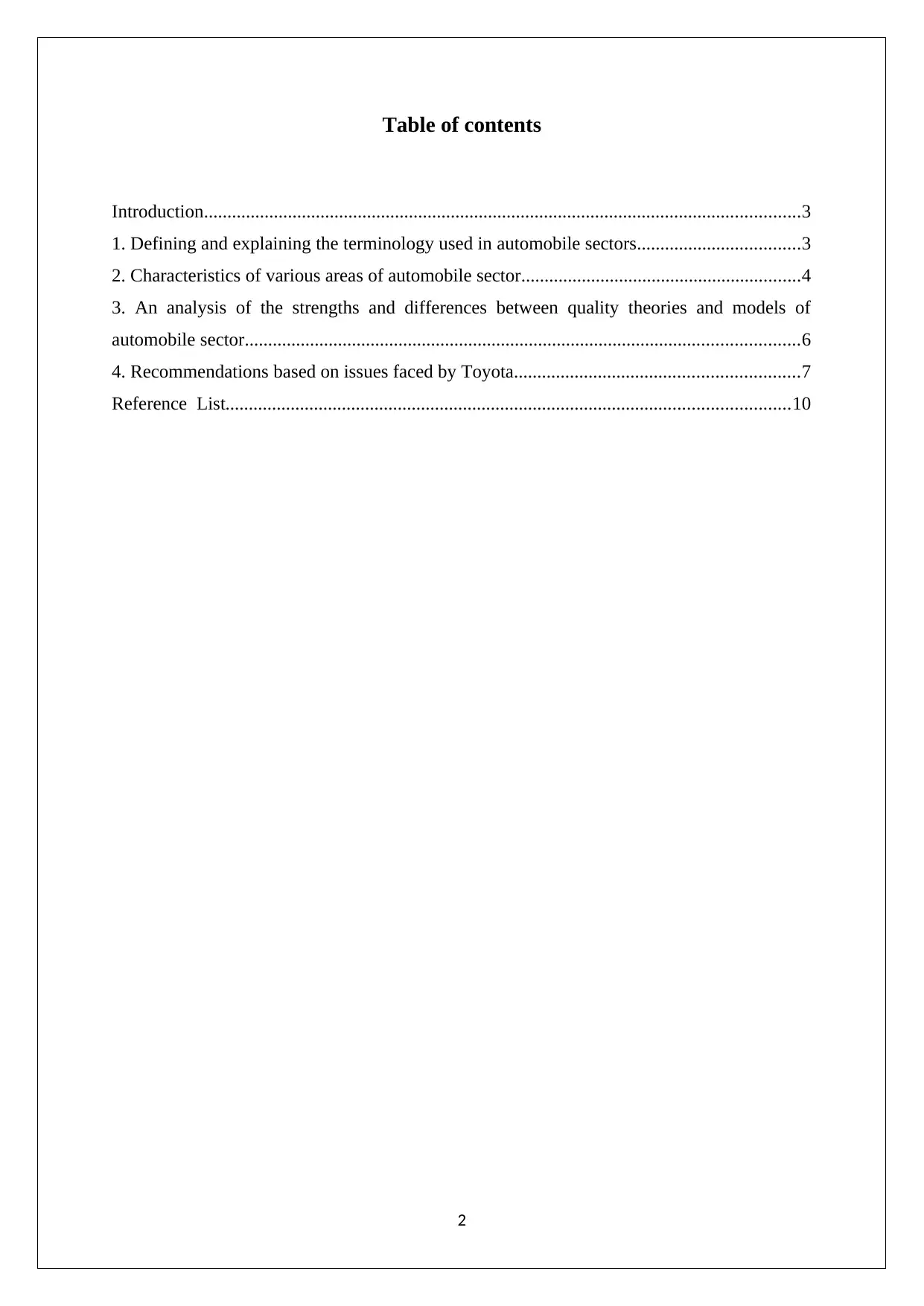
Table of contents
Introduction................................................................................................................................3
1. Defining and explaining the terminology used in automobile sectors...................................3
2. Characteristics of various areas of automobile sector............................................................4
3. An analysis of the strengths and differences between quality theories and models of
automobile sector.......................................................................................................................6
4. Recommendations based on issues faced by Toyota.............................................................7
Reference List.........................................................................................................................10
2
Introduction................................................................................................................................3
1. Defining and explaining the terminology used in automobile sectors...................................3
2. Characteristics of various areas of automobile sector............................................................4
3. An analysis of the strengths and differences between quality theories and models of
automobile sector.......................................................................................................................6
4. Recommendations based on issues faced by Toyota.............................................................7
Reference List.........................................................................................................................10
2

Introduction
The main aim of this assignment is that to focus on the scope of the different theories applied
in the service quality of Toyota automobile sectors. This assignment studies the terminology
used in the automobile sectors, characteristics of the different areas of the automobile sectors
and it analyses the strengths and the differences between the different theories of the
automobile sectors. The above mentioned points are discussed in this study.
1. Defining and explaining the terminology used in automobile sectors
Kaizen model
This model focuses on the ways by which a business can be developed in a better way to fight
with the competitors. It also focuses on the ways of improving the better quality services to
the customers so that they are satisfied by the services. On the other side, the manufacturing
teams must use advanced technologies in the production purpose so that they can produce
better quality goods and services. Among all the models Kaizen model was one of the models
that have been applied by different automobile industries. Moreover, Toyota has adopted this
model in order to develop their business in a better way. Estampel et al. (2013, p.247),
opined that this model helps in the continuous development of the business. On the other
side, it has been analysed that the methodologies are similar. The automobile industries are
using the similar methods in order to provide better services to the customers. Additionally, it
also reduces the operational expenses of the organisations and it also makes continuous
improvements of the organisations so that they can prosper in future.
Additionally, while using these models in the industry it also helps in eliminating the waste of
the raw materials of the organisations and it helps the industry to improve the production of
the goods and services as well as the quality of the goods and the services. Wells et al. (2012,
p.168), opined that additionally, it has been analysed by the researchers that this model has
been applied by the different automobile industries. From the Kaizen model, it can be
analysed that it forms a team and gathers information. This states that the ideas are being
observed and they are examined in order to gather information regarding the process. On the
other side, it also focuses on the needs of the process that the teams will focus at the time of
improvement. Last but not the least; it also selects the goals or the objectives of the business.
In this stage, the team focuses on how better technologies that can be adopted in the
3
The main aim of this assignment is that to focus on the scope of the different theories applied
in the service quality of Toyota automobile sectors. This assignment studies the terminology
used in the automobile sectors, characteristics of the different areas of the automobile sectors
and it analyses the strengths and the differences between the different theories of the
automobile sectors. The above mentioned points are discussed in this study.
1. Defining and explaining the terminology used in automobile sectors
Kaizen model
This model focuses on the ways by which a business can be developed in a better way to fight
with the competitors. It also focuses on the ways of improving the better quality services to
the customers so that they are satisfied by the services. On the other side, the manufacturing
teams must use advanced technologies in the production purpose so that they can produce
better quality goods and services. Among all the models Kaizen model was one of the models
that have been applied by different automobile industries. Moreover, Toyota has adopted this
model in order to develop their business in a better way. Estampel et al. (2013, p.247),
opined that this model helps in the continuous development of the business. On the other
side, it has been analysed that the methodologies are similar. The automobile industries are
using the similar methods in order to provide better services to the customers. Additionally, it
also reduces the operational expenses of the organisations and it also makes continuous
improvements of the organisations so that they can prosper in future.
Additionally, while using these models in the industry it also helps in eliminating the waste of
the raw materials of the organisations and it helps the industry to improve the production of
the goods and services as well as the quality of the goods and the services. Wells et al. (2012,
p.168), opined that additionally, it has been analysed by the researchers that this model has
been applied by the different automobile industries. From the Kaizen model, it can be
analysed that it forms a team and gathers information. This states that the ideas are being
observed and they are examined in order to gather information regarding the process. On the
other side, it also focuses on the needs of the process that the teams will focus at the time of
improvement. Last but not the least; it also selects the goals or the objectives of the business.
In this stage, the team focuses on how better technologies that can be adopted in the
3
⊘ This is a preview!⊘
Do you want full access?
Subscribe today to unlock all pages.

Trusted by 1+ million students worldwide
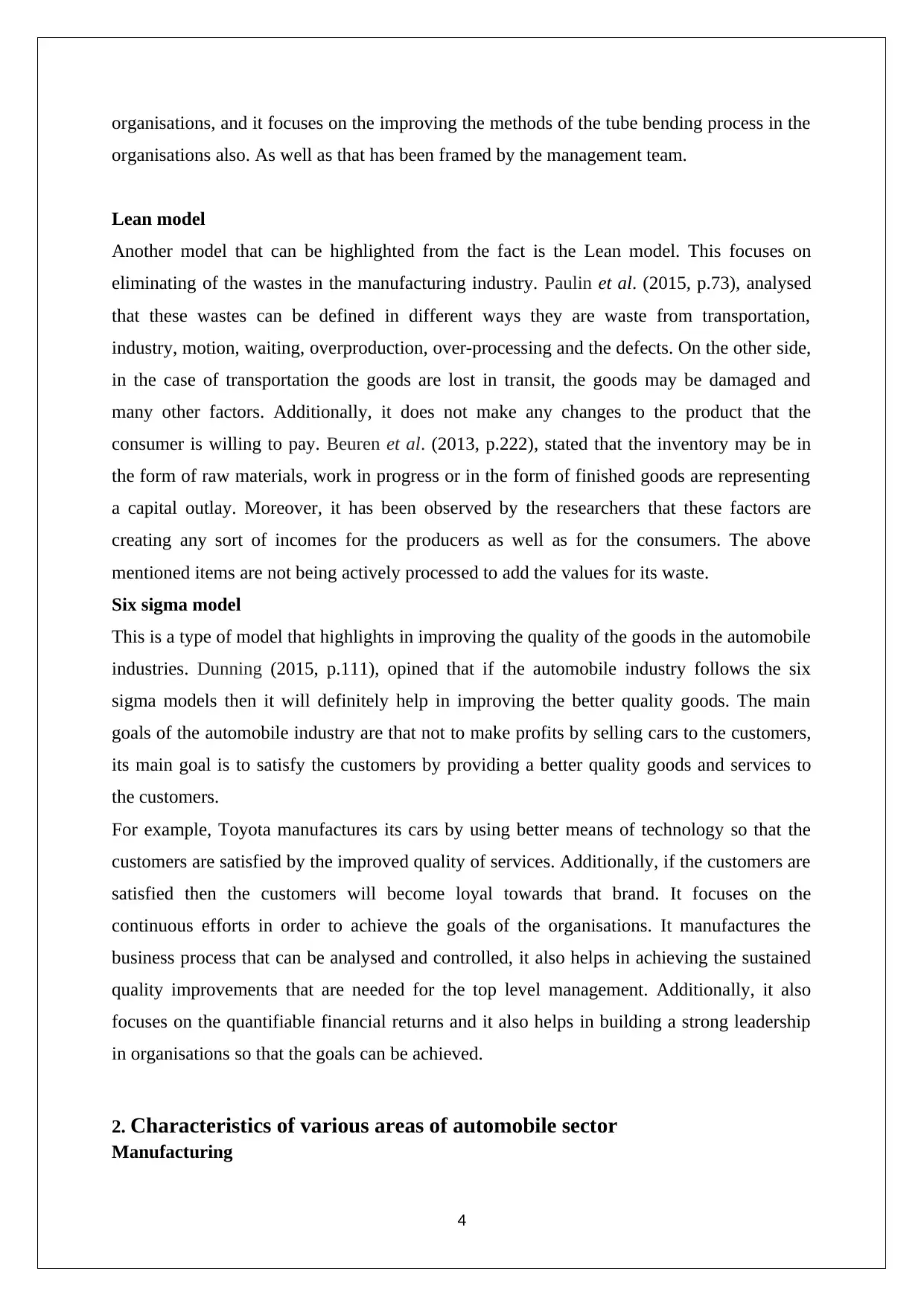
organisations, and it focuses on the improving the methods of the tube bending process in the
organisations also. As well as that has been framed by the management team.
Lean model
Another model that can be highlighted from the fact is the Lean model. This focuses on
eliminating of the wastes in the manufacturing industry. Paulin et al. (2015, p.73), analysed
that these wastes can be defined in different ways they are waste from transportation,
industry, motion, waiting, overproduction, over-processing and the defects. On the other side,
in the case of transportation the goods are lost in transit, the goods may be damaged and
many other factors. Additionally, it does not make any changes to the product that the
consumer is willing to pay. Beuren et al. (2013, p.222), stated that the inventory may be in
the form of raw materials, work in progress or in the form of finished goods are representing
a capital outlay. Moreover, it has been observed by the researchers that these factors are
creating any sort of incomes for the producers as well as for the consumers. The above
mentioned items are not being actively processed to add the values for its waste.
Six sigma model
This is a type of model that highlights in improving the quality of the goods in the automobile
industries. Dunning (2015, p.111), opined that if the automobile industry follows the six
sigma models then it will definitely help in improving the better quality goods. The main
goals of the automobile industry are that not to make profits by selling cars to the customers,
its main goal is to satisfy the customers by providing a better quality goods and services to
the customers.
For example, Toyota manufactures its cars by using better means of technology so that the
customers are satisfied by the improved quality of services. Additionally, if the customers are
satisfied then the customers will become loyal towards that brand. It focuses on the
continuous efforts in order to achieve the goals of the organisations. It manufactures the
business process that can be analysed and controlled, it also helps in achieving the sustained
quality improvements that are needed for the top level management. Additionally, it also
focuses on the quantifiable financial returns and it also helps in building a strong leadership
in organisations so that the goals can be achieved.
2. Characteristics of various areas of automobile sector
Manufacturing
4
organisations also. As well as that has been framed by the management team.
Lean model
Another model that can be highlighted from the fact is the Lean model. This focuses on
eliminating of the wastes in the manufacturing industry. Paulin et al. (2015, p.73), analysed
that these wastes can be defined in different ways they are waste from transportation,
industry, motion, waiting, overproduction, over-processing and the defects. On the other side,
in the case of transportation the goods are lost in transit, the goods may be damaged and
many other factors. Additionally, it does not make any changes to the product that the
consumer is willing to pay. Beuren et al. (2013, p.222), stated that the inventory may be in
the form of raw materials, work in progress or in the form of finished goods are representing
a capital outlay. Moreover, it has been observed by the researchers that these factors are
creating any sort of incomes for the producers as well as for the consumers. The above
mentioned items are not being actively processed to add the values for its waste.
Six sigma model
This is a type of model that highlights in improving the quality of the goods in the automobile
industries. Dunning (2015, p.111), opined that if the automobile industry follows the six
sigma models then it will definitely help in improving the better quality goods. The main
goals of the automobile industry are that not to make profits by selling cars to the customers,
its main goal is to satisfy the customers by providing a better quality goods and services to
the customers.
For example, Toyota manufactures its cars by using better means of technology so that the
customers are satisfied by the improved quality of services. Additionally, if the customers are
satisfied then the customers will become loyal towards that brand. It focuses on the
continuous efforts in order to achieve the goals of the organisations. It manufactures the
business process that can be analysed and controlled, it also helps in achieving the sustained
quality improvements that are needed for the top level management. Additionally, it also
focuses on the quantifiable financial returns and it also helps in building a strong leadership
in organisations so that the goals can be achieved.
2. Characteristics of various areas of automobile sector
Manufacturing
4
Paraphrase This Document
Need a fresh take? Get an instant paraphrase of this document with our AI Paraphraser
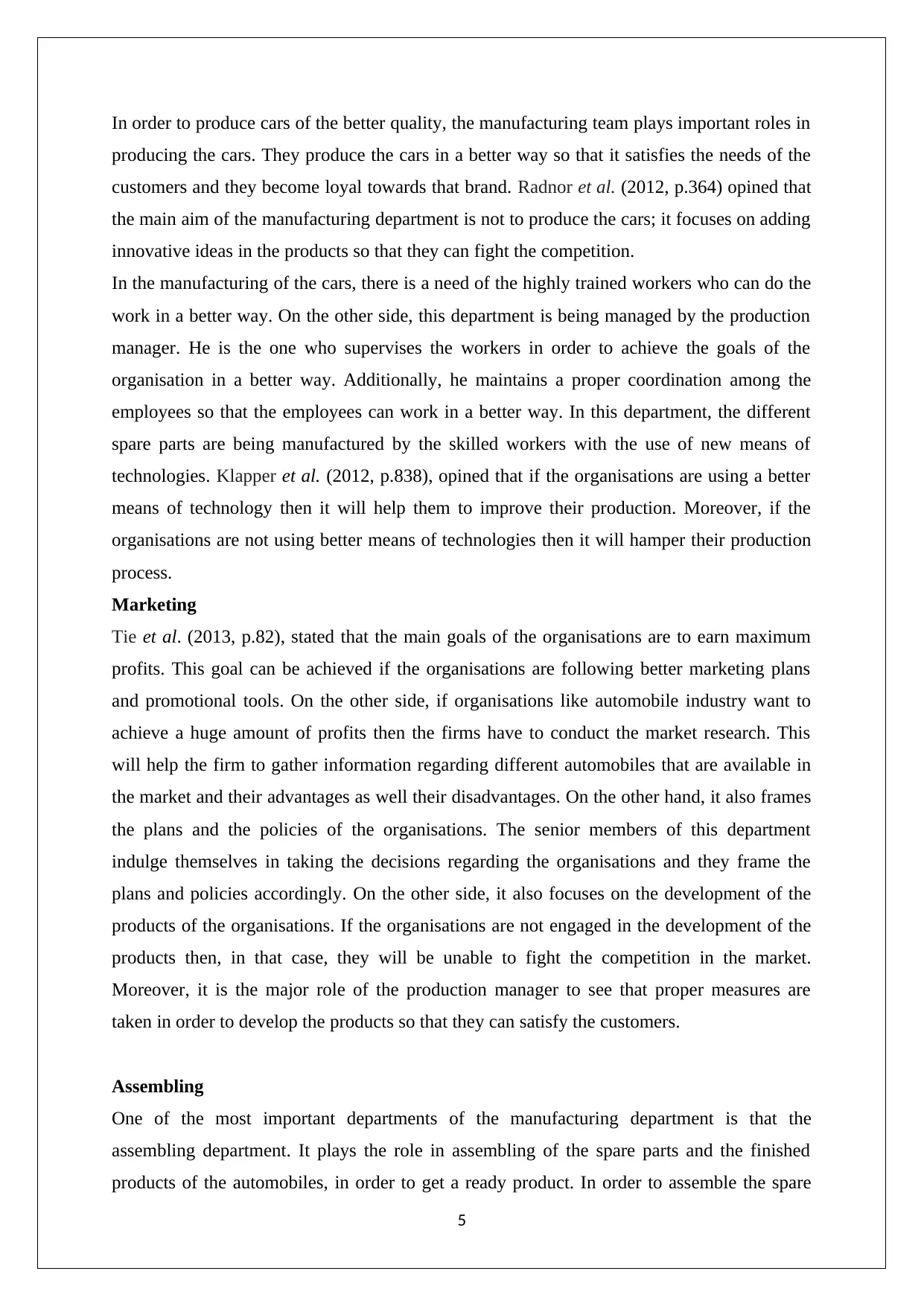
In order to produce cars of the better quality, the manufacturing team plays important roles in
producing the cars. They produce the cars in a better way so that it satisfies the needs of the
customers and they become loyal towards that brand. Radnor et al. (2012, p.364) opined that
the main aim of the manufacturing department is not to produce the cars; it focuses on adding
innovative ideas in the products so that they can fight the competition.
In the manufacturing of the cars, there is a need of the highly trained workers who can do the
work in a better way. On the other side, this department is being managed by the production
manager. He is the one who supervises the workers in order to achieve the goals of the
organisation in a better way. Additionally, he maintains a proper coordination among the
employees so that the employees can work in a better way. In this department, the different
spare parts are being manufactured by the skilled workers with the use of new means of
technologies. Klapper et al. (2012, p.838), opined that if the organisations are using a better
means of technology then it will help them to improve their production. Moreover, if the
organisations are not using better means of technologies then it will hamper their production
process.
Marketing
Tie et al. (2013, p.82), stated that the main goals of the organisations are to earn maximum
profits. This goal can be achieved if the organisations are following better marketing plans
and promotional tools. On the other side, if organisations like automobile industry want to
achieve a huge amount of profits then the firms have to conduct the market research. This
will help the firm to gather information regarding different automobiles that are available in
the market and their advantages as well their disadvantages. On the other hand, it also frames
the plans and the policies of the organisations. The senior members of this department
indulge themselves in taking the decisions regarding the organisations and they frame the
plans and policies accordingly. On the other side, it also focuses on the development of the
products of the organisations. If the organisations are not engaged in the development of the
products then, in that case, they will be unable to fight the competition in the market.
Moreover, it is the major role of the production manager to see that proper measures are
taken in order to develop the products so that they can satisfy the customers.
Assembling
One of the most important departments of the manufacturing department is that the
assembling department. It plays the role in assembling of the spare parts and the finished
products of the automobiles, in order to get a ready product. In order to assemble the spare
5
producing the cars. They produce the cars in a better way so that it satisfies the needs of the
customers and they become loyal towards that brand. Radnor et al. (2012, p.364) opined that
the main aim of the manufacturing department is not to produce the cars; it focuses on adding
innovative ideas in the products so that they can fight the competition.
In the manufacturing of the cars, there is a need of the highly trained workers who can do the
work in a better way. On the other side, this department is being managed by the production
manager. He is the one who supervises the workers in order to achieve the goals of the
organisation in a better way. Additionally, he maintains a proper coordination among the
employees so that the employees can work in a better way. In this department, the different
spare parts are being manufactured by the skilled workers with the use of new means of
technologies. Klapper et al. (2012, p.838), opined that if the organisations are using a better
means of technology then it will help them to improve their production. Moreover, if the
organisations are not using better means of technologies then it will hamper their production
process.
Marketing
Tie et al. (2013, p.82), stated that the main goals of the organisations are to earn maximum
profits. This goal can be achieved if the organisations are following better marketing plans
and promotional tools. On the other side, if organisations like automobile industry want to
achieve a huge amount of profits then the firms have to conduct the market research. This
will help the firm to gather information regarding different automobiles that are available in
the market and their advantages as well their disadvantages. On the other hand, it also frames
the plans and the policies of the organisations. The senior members of this department
indulge themselves in taking the decisions regarding the organisations and they frame the
plans and policies accordingly. On the other side, it also focuses on the development of the
products of the organisations. If the organisations are not engaged in the development of the
products then, in that case, they will be unable to fight the competition in the market.
Moreover, it is the major role of the production manager to see that proper measures are
taken in order to develop the products so that they can satisfy the customers.
Assembling
One of the most important departments of the manufacturing department is that the
assembling department. It plays the role in assembling of the spare parts and the finished
products of the automobiles, in order to get a ready product. In order to assemble the spare
5
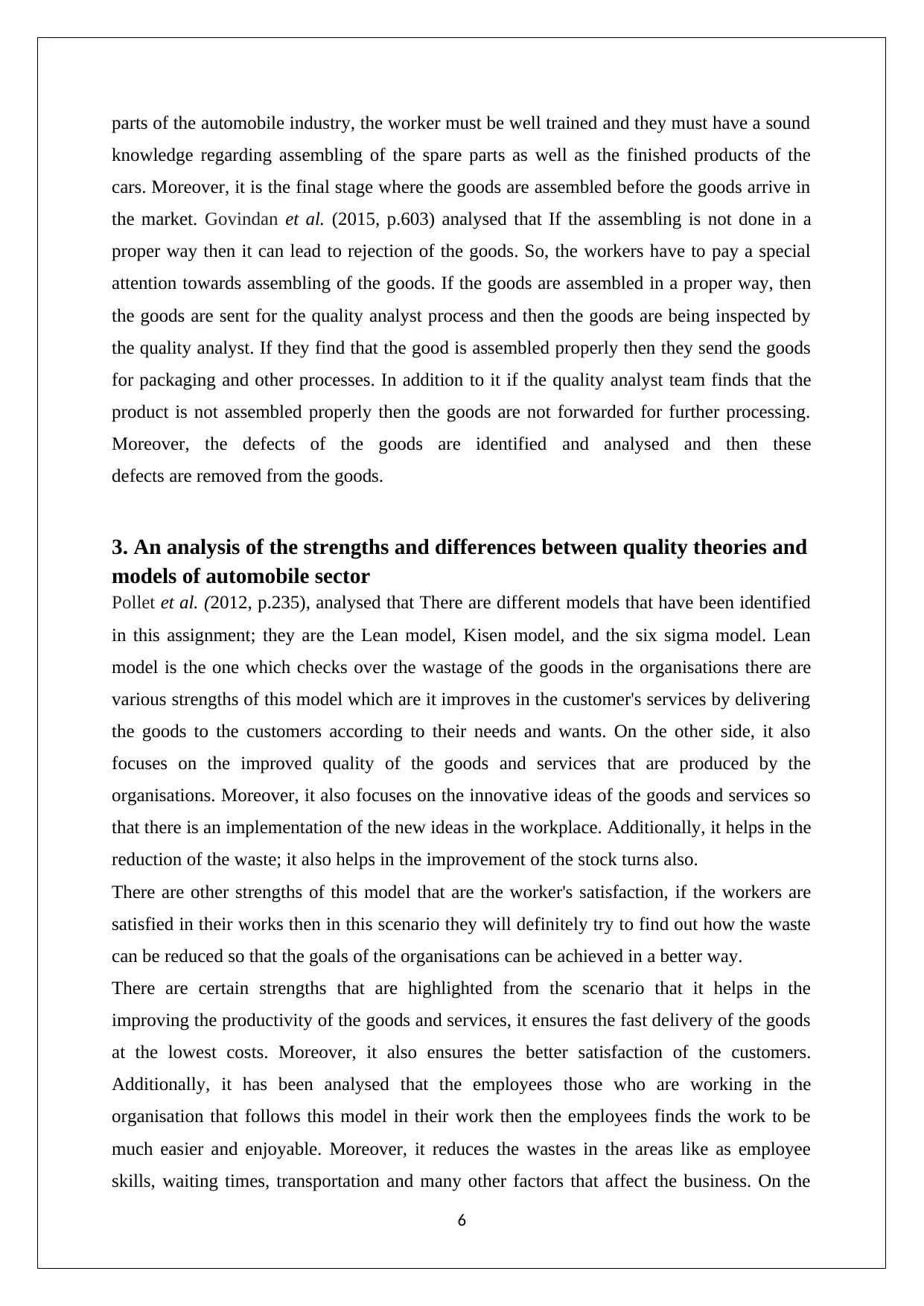
parts of the automobile industry, the worker must be well trained and they must have a sound
knowledge regarding assembling of the spare parts as well as the finished products of the
cars. Moreover, it is the final stage where the goods are assembled before the goods arrive in
the market. Govindan et al. (2015, p.603) analysed that If the assembling is not done in a
proper way then it can lead to rejection of the goods. So, the workers have to pay a special
attention towards assembling of the goods. If the goods are assembled in a proper way, then
the goods are sent for the quality analyst process and then the goods are being inspected by
the quality analyst. If they find that the good is assembled properly then they send the goods
for packaging and other processes. In addition to it if the quality analyst team finds that the
product is not assembled properly then the goods are not forwarded for further processing.
Moreover, the defects of the goods are identified and analysed and then these
defects are removed from the goods.
3. An analysis of the strengths and differences between quality theories and
models of automobile sector
Pollet et al. (2012, p.235), analysed that There are different models that have been identified
in this assignment; they are the Lean model, Kisen model, and the six sigma model. Lean
model is the one which checks over the wastage of the goods in the organisations there are
various strengths of this model which are it improves in the customer's services by delivering
the goods to the customers according to their needs and wants. On the other side, it also
focuses on the improved quality of the goods and services that are produced by the
organisations. Moreover, it also focuses on the innovative ideas of the goods and services so
that there is an implementation of the new ideas in the workplace. Additionally, it helps in the
reduction of the waste; it also helps in the improvement of the stock turns also.
There are other strengths of this model that are the worker's satisfaction, if the workers are
satisfied in their works then in this scenario they will definitely try to find out how the waste
can be reduced so that the goals of the organisations can be achieved in a better way.
There are certain strengths that are highlighted from the scenario that it helps in the
improving the productivity of the goods and services, it ensures the fast delivery of the goods
at the lowest costs. Moreover, it also ensures the better satisfaction of the customers.
Additionally, it has been analysed that the employees those who are working in the
organisation that follows this model in their work then the employees finds the work to be
much easier and enjoyable. Moreover, it reduces the wastes in the areas like as employee
skills, waiting times, transportation and many other factors that affect the business. On the
6
knowledge regarding assembling of the spare parts as well as the finished products of the
cars. Moreover, it is the final stage where the goods are assembled before the goods arrive in
the market. Govindan et al. (2015, p.603) analysed that If the assembling is not done in a
proper way then it can lead to rejection of the goods. So, the workers have to pay a special
attention towards assembling of the goods. If the goods are assembled in a proper way, then
the goods are sent for the quality analyst process and then the goods are being inspected by
the quality analyst. If they find that the good is assembled properly then they send the goods
for packaging and other processes. In addition to it if the quality analyst team finds that the
product is not assembled properly then the goods are not forwarded for further processing.
Moreover, the defects of the goods are identified and analysed and then these
defects are removed from the goods.
3. An analysis of the strengths and differences between quality theories and
models of automobile sector
Pollet et al. (2012, p.235), analysed that There are different models that have been identified
in this assignment; they are the Lean model, Kisen model, and the six sigma model. Lean
model is the one which checks over the wastage of the goods in the organisations there are
various strengths of this model which are it improves in the customer's services by delivering
the goods to the customers according to their needs and wants. On the other side, it also
focuses on the improved quality of the goods and services that are produced by the
organisations. Moreover, it also focuses on the innovative ideas of the goods and services so
that there is an implementation of the new ideas in the workplace. Additionally, it helps in the
reduction of the waste; it also helps in the improvement of the stock turns also.
There are other strengths of this model that are the worker's satisfaction, if the workers are
satisfied in their works then in this scenario they will definitely try to find out how the waste
can be reduced so that the goals of the organisations can be achieved in a better way.
There are certain strengths that are highlighted from the scenario that it helps in the
improving the productivity of the goods and services, it ensures the fast delivery of the goods
at the lowest costs. Moreover, it also ensures the better satisfaction of the customers.
Additionally, it has been analysed that the employees those who are working in the
organisation that follows this model in their work then the employees finds the work to be
much easier and enjoyable. Moreover, it reduces the wastes in the areas like as employee
skills, waiting times, transportation and many other factors that affect the business. On the
6
⊘ This is a preview!⊘
Do you want full access?
Subscribe today to unlock all pages.

Trusted by 1+ million students worldwide
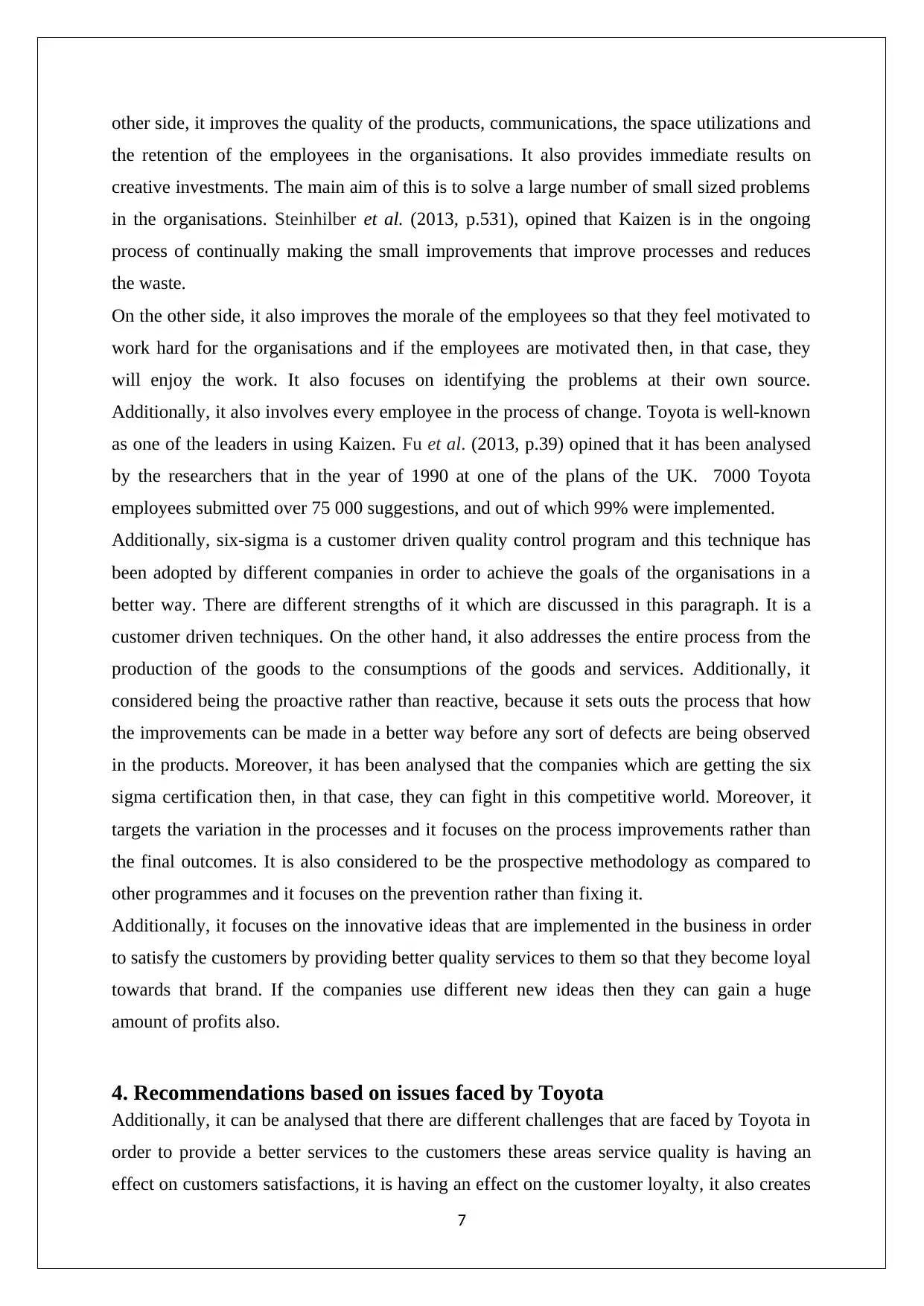
other side, it improves the quality of the products, communications, the space utilizations and
the retention of the employees in the organisations. It also provides immediate results on
creative investments. The main aim of this is to solve a large number of small sized problems
in the organisations. Steinhilber et al. (2013, p.531), opined that Kaizen is in the ongoing
process of continually making the small improvements that improve processes and reduces
the waste.
On the other side, it also improves the morale of the employees so that they feel motivated to
work hard for the organisations and if the employees are motivated then, in that case, they
will enjoy the work. It also focuses on identifying the problems at their own source.
Additionally, it also involves every employee in the process of change. Toyota is well-known
as one of the leaders in using Kaizen. Fu et al. (2013, p.39) opined that it has been analysed
by the researchers that in the year of 1990 at one of the plans of the UK. 7000 Toyota
employees submitted over 75 000 suggestions, and out of which 99% were implemented.
Additionally, six-sigma is a customer driven quality control program and this technique has
been adopted by different companies in order to achieve the goals of the organisations in a
better way. There are different strengths of it which are discussed in this paragraph. It is a
customer driven techniques. On the other hand, it also addresses the entire process from the
production of the goods to the consumptions of the goods and services. Additionally, it
considered being the proactive rather than reactive, because it sets outs the process that how
the improvements can be made in a better way before any sort of defects are being observed
in the products. Moreover, it has been analysed that the companies which are getting the six
sigma certification then, in that case, they can fight in this competitive world. Moreover, it
targets the variation in the processes and it focuses on the process improvements rather than
the final outcomes. It is also considered to be the prospective methodology as compared to
other programmes and it focuses on the prevention rather than fixing it.
Additionally, it focuses on the innovative ideas that are implemented in the business in order
to satisfy the customers by providing better quality services to them so that they become loyal
towards that brand. If the companies use different new ideas then they can gain a huge
amount of profits also.
4. Recommendations based on issues faced by Toyota
Additionally, it can be analysed that there are different challenges that are faced by Toyota in
order to provide a better services to the customers these areas service quality is having an
effect on customers satisfactions, it is having an effect on the customer loyalty, it also creates
7
the retention of the employees in the organisations. It also provides immediate results on
creative investments. The main aim of this is to solve a large number of small sized problems
in the organisations. Steinhilber et al. (2013, p.531), opined that Kaizen is in the ongoing
process of continually making the small improvements that improve processes and reduces
the waste.
On the other side, it also improves the morale of the employees so that they feel motivated to
work hard for the organisations and if the employees are motivated then, in that case, they
will enjoy the work. It also focuses on identifying the problems at their own source.
Additionally, it also involves every employee in the process of change. Toyota is well-known
as one of the leaders in using Kaizen. Fu et al. (2013, p.39) opined that it has been analysed
by the researchers that in the year of 1990 at one of the plans of the UK. 7000 Toyota
employees submitted over 75 000 suggestions, and out of which 99% were implemented.
Additionally, six-sigma is a customer driven quality control program and this technique has
been adopted by different companies in order to achieve the goals of the organisations in a
better way. There are different strengths of it which are discussed in this paragraph. It is a
customer driven techniques. On the other hand, it also addresses the entire process from the
production of the goods to the consumptions of the goods and services. Additionally, it
considered being the proactive rather than reactive, because it sets outs the process that how
the improvements can be made in a better way before any sort of defects are being observed
in the products. Moreover, it has been analysed that the companies which are getting the six
sigma certification then, in that case, they can fight in this competitive world. Moreover, it
targets the variation in the processes and it focuses on the process improvements rather than
the final outcomes. It is also considered to be the prospective methodology as compared to
other programmes and it focuses on the prevention rather than fixing it.
Additionally, it focuses on the innovative ideas that are implemented in the business in order
to satisfy the customers by providing better quality services to them so that they become loyal
towards that brand. If the companies use different new ideas then they can gain a huge
amount of profits also.
4. Recommendations based on issues faced by Toyota
Additionally, it can be analysed that there are different challenges that are faced by Toyota in
order to provide a better services to the customers these areas service quality is having an
effect on customers satisfactions, it is having an effect on the customer loyalty, it also creates
7
Paraphrase This Document
Need a fresh take? Get an instant paraphrase of this document with our AI Paraphraser
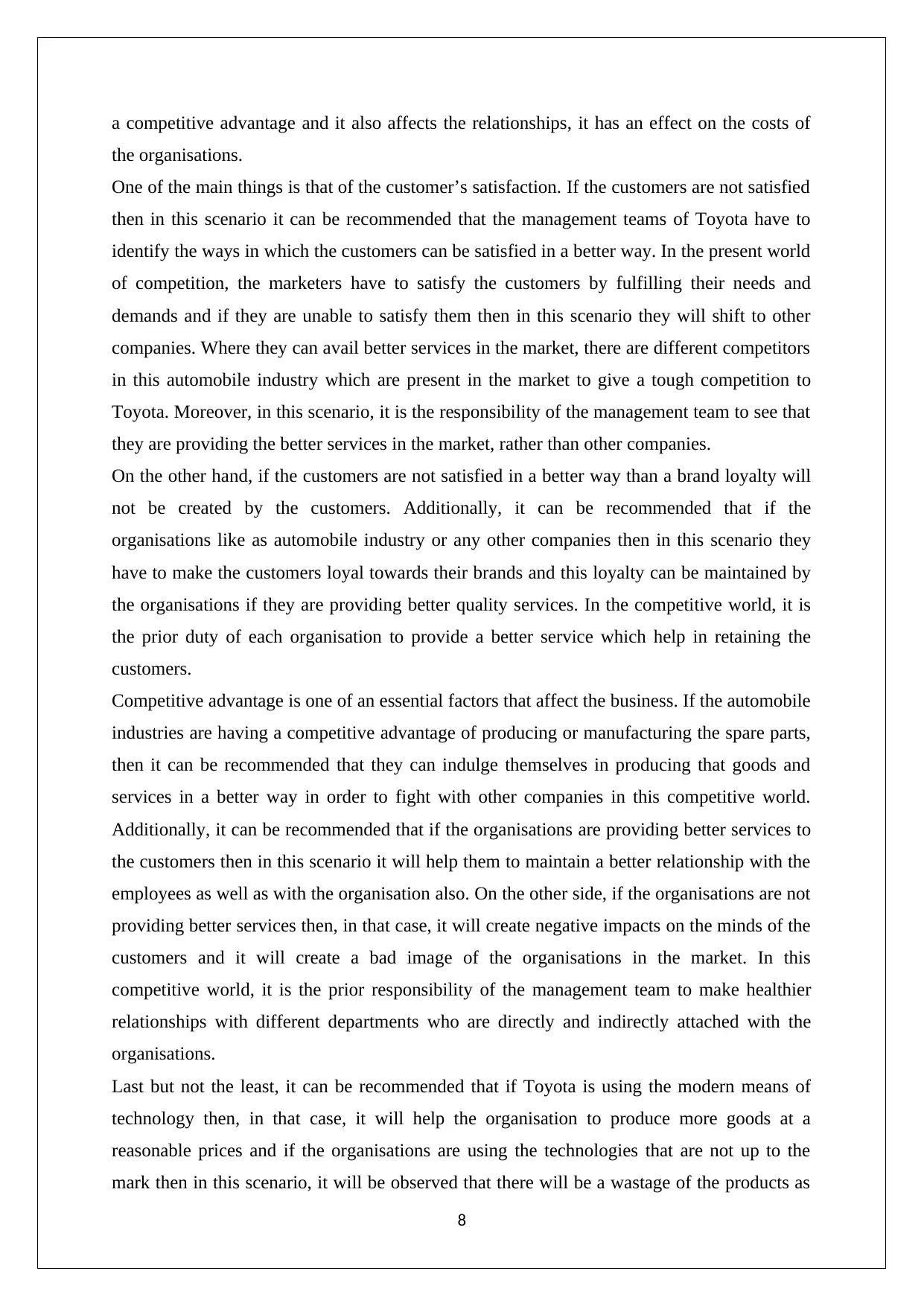
a competitive advantage and it also affects the relationships, it has an effect on the costs of
the organisations.
One of the main things is that of the customer’s satisfaction. If the customers are not satisfied
then in this scenario it can be recommended that the management teams of Toyota have to
identify the ways in which the customers can be satisfied in a better way. In the present world
of competition, the marketers have to satisfy the customers by fulfilling their needs and
demands and if they are unable to satisfy them then in this scenario they will shift to other
companies. Where they can avail better services in the market, there are different competitors
in this automobile industry which are present in the market to give a tough competition to
Toyota. Moreover, in this scenario, it is the responsibility of the management team to see that
they are providing the better services in the market, rather than other companies.
On the other hand, if the customers are not satisfied in a better way than a brand loyalty will
not be created by the customers. Additionally, it can be recommended that if the
organisations like as automobile industry or any other companies then in this scenario they
have to make the customers loyal towards their brands and this loyalty can be maintained by
the organisations if they are providing better quality services. In the competitive world, it is
the prior duty of each organisation to provide a better service which help in retaining the
customers.
Competitive advantage is one of an essential factors that affect the business. If the automobile
industries are having a competitive advantage of producing or manufacturing the spare parts,
then it can be recommended that they can indulge themselves in producing that goods and
services in a better way in order to fight with other companies in this competitive world.
Additionally, it can be recommended that if the organisations are providing better services to
the customers then in this scenario it will help them to maintain a better relationship with the
employees as well as with the organisation also. On the other side, if the organisations are not
providing better services then, in that case, it will create negative impacts on the minds of the
customers and it will create a bad image of the organisations in the market. In this
competitive world, it is the prior responsibility of the management team to make healthier
relationships with different departments who are directly and indirectly attached with the
organisations.
Last but not the least, it can be recommended that if Toyota is using the modern means of
technology then, in that case, it will help the organisation to produce more goods at a
reasonable prices and if the organisations are using the technologies that are not up to the
mark then in this scenario, it will be observed that there will be a wastage of the products as
8
the organisations.
One of the main things is that of the customer’s satisfaction. If the customers are not satisfied
then in this scenario it can be recommended that the management teams of Toyota have to
identify the ways in which the customers can be satisfied in a better way. In the present world
of competition, the marketers have to satisfy the customers by fulfilling their needs and
demands and if they are unable to satisfy them then in this scenario they will shift to other
companies. Where they can avail better services in the market, there are different competitors
in this automobile industry which are present in the market to give a tough competition to
Toyota. Moreover, in this scenario, it is the responsibility of the management team to see that
they are providing the better services in the market, rather than other companies.
On the other hand, if the customers are not satisfied in a better way than a brand loyalty will
not be created by the customers. Additionally, it can be recommended that if the
organisations like as automobile industry or any other companies then in this scenario they
have to make the customers loyal towards their brands and this loyalty can be maintained by
the organisations if they are providing better quality services. In the competitive world, it is
the prior duty of each organisation to provide a better service which help in retaining the
customers.
Competitive advantage is one of an essential factors that affect the business. If the automobile
industries are having a competitive advantage of producing or manufacturing the spare parts,
then it can be recommended that they can indulge themselves in producing that goods and
services in a better way in order to fight with other companies in this competitive world.
Additionally, it can be recommended that if the organisations are providing better services to
the customers then in this scenario it will help them to maintain a better relationship with the
employees as well as with the organisation also. On the other side, if the organisations are not
providing better services then, in that case, it will create negative impacts on the minds of the
customers and it will create a bad image of the organisations in the market. In this
competitive world, it is the prior responsibility of the management team to make healthier
relationships with different departments who are directly and indirectly attached with the
organisations.
Last but not the least, it can be recommended that if Toyota is using the modern means of
technology then, in that case, it will help the organisation to produce more goods at a
reasonable prices and if the organisations are using the technologies that are not up to the
mark then in this scenario, it will be observed that there will be a wastage of the products as
8

well as the raw materials also. Additionally, it will also increase the cost of production and
the operating costs of the organisations. On the other side, it can be recommended that
tangibles of the organisations have to be increased in order to provide betters services to the
customers. In other words, the tangibles can be considered to be the physical resources of the
organisations. Moreover, Toyota has to make the customers reliable so that the customers
feel that they are getting the promised services that have been given by the organisations. If it
is found that the customers are getting reliable services then it will definitely help them to
increase the goodwill and profit of the organisations. Additionally, it is one of the main
responsibilities of the organisations that an assurance has e to be maintained in the
organisations so that the trust and confidence are being maintained among the employees.
Additionally, it is the responsibility of the organisations that to give empathy to the customers
that they will get better quality products and services.
Conclusion
From the above discussion it can be concluded that there are different theories that are related
to the automobile industry. Moreover, there are different models and theories that have been
discussed in this study. On the other side, recommendations and roles of different
departments of the automobile industries have been discussed in this study. Additionally, in
this modern world of tough competition, it has been recommended that in order to survive in
the market the organisations have to provide better services to the customers so that the
customer’s retention can be maintained.
9
the operating costs of the organisations. On the other side, it can be recommended that
tangibles of the organisations have to be increased in order to provide betters services to the
customers. In other words, the tangibles can be considered to be the physical resources of the
organisations. Moreover, Toyota has to make the customers reliable so that the customers
feel that they are getting the promised services that have been given by the organisations. If it
is found that the customers are getting reliable services then it will definitely help them to
increase the goodwill and profit of the organisations. Additionally, it is one of the main
responsibilities of the organisations that an assurance has e to be maintained in the
organisations so that the trust and confidence are being maintained among the employees.
Additionally, it is the responsibility of the organisations that to give empathy to the customers
that they will get better quality products and services.
Conclusion
From the above discussion it can be concluded that there are different theories that are related
to the automobile industry. Moreover, there are different models and theories that have been
discussed in this study. On the other side, recommendations and roles of different
departments of the automobile industries have been discussed in this study. Additionally, in
this modern world of tough competition, it has been recommended that in order to survive in
the market the organisations have to provide better services to the customers so that the
customer’s retention can be maintained.
9
⊘ This is a preview!⊘
Do you want full access?
Subscribe today to unlock all pages.

Trusted by 1+ million students worldwide
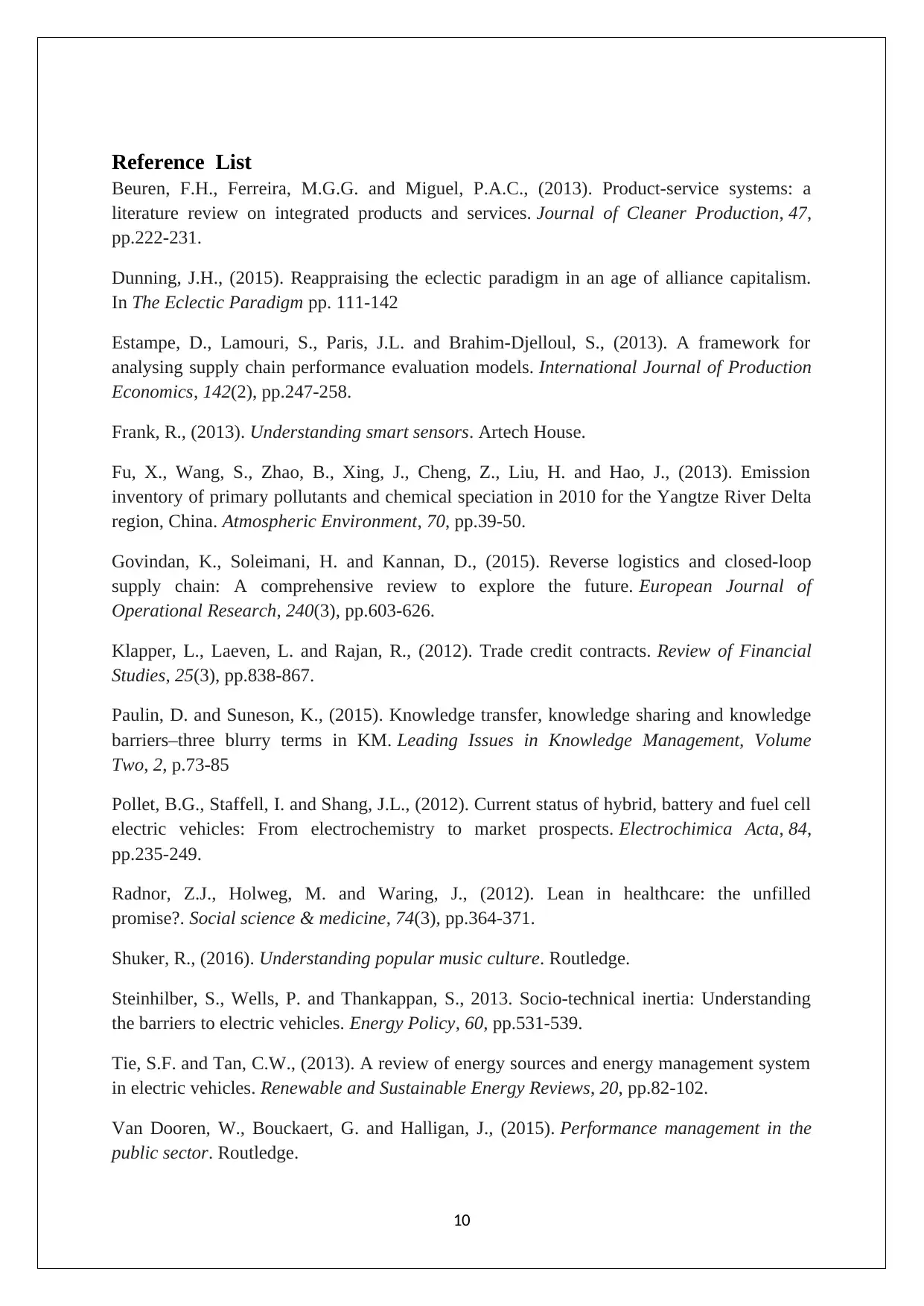
Reference List
Beuren, F.H., Ferreira, M.G.G. and Miguel, P.A.C., (2013). Product-service systems: a
literature review on integrated products and services. Journal of Cleaner Production, 47,
pp.222-231.
Dunning, J.H., (2015). Reappraising the eclectic paradigm in an age of alliance capitalism.
In The Eclectic Paradigm pp. 111-142
Estampe, D., Lamouri, S., Paris, J.L. and Brahim-Djelloul, S., (2013). A framework for
analysing supply chain performance evaluation models. International Journal of Production
Economics, 142(2), pp.247-258.
Frank, R., (2013). Understanding smart sensors. Artech House.
Fu, X., Wang, S., Zhao, B., Xing, J., Cheng, Z., Liu, H. and Hao, J., (2013). Emission
inventory of primary pollutants and chemical speciation in 2010 for the Yangtze River Delta
region, China. Atmospheric Environment, 70, pp.39-50.
Govindan, K., Soleimani, H. and Kannan, D., (2015). Reverse logistics and closed-loop
supply chain: A comprehensive review to explore the future. European Journal of
Operational Research, 240(3), pp.603-626.
Klapper, L., Laeven, L. and Rajan, R., (2012). Trade credit contracts. Review of Financial
Studies, 25(3), pp.838-867.
Paulin, D. and Suneson, K., (2015). Knowledge transfer, knowledge sharing and knowledge
barriers–three blurry terms in KM. Leading Issues in Knowledge Management, Volume
Two, 2, p.73-85
Pollet, B.G., Staffell, I. and Shang, J.L., (2012). Current status of hybrid, battery and fuel cell
electric vehicles: From electrochemistry to market prospects. Electrochimica Acta, 84,
pp.235-249.
Radnor, Z.J., Holweg, M. and Waring, J., (2012). Lean in healthcare: the unfilled
promise?. Social science & medicine, 74(3), pp.364-371.
Shuker, R., (2016). Understanding popular music culture. Routledge.
Steinhilber, S., Wells, P. and Thankappan, S., 2013. Socio-technical inertia: Understanding
the barriers to electric vehicles. Energy Policy, 60, pp.531-539.
Tie, S.F. and Tan, C.W., (2013). A review of energy sources and energy management system
in electric vehicles. Renewable and Sustainable Energy Reviews, 20, pp.82-102.
Van Dooren, W., Bouckaert, G. and Halligan, J., (2015). Performance management in the
public sector. Routledge.
10
Beuren, F.H., Ferreira, M.G.G. and Miguel, P.A.C., (2013). Product-service systems: a
literature review on integrated products and services. Journal of Cleaner Production, 47,
pp.222-231.
Dunning, J.H., (2015). Reappraising the eclectic paradigm in an age of alliance capitalism.
In The Eclectic Paradigm pp. 111-142
Estampe, D., Lamouri, S., Paris, J.L. and Brahim-Djelloul, S., (2013). A framework for
analysing supply chain performance evaluation models. International Journal of Production
Economics, 142(2), pp.247-258.
Frank, R., (2013). Understanding smart sensors. Artech House.
Fu, X., Wang, S., Zhao, B., Xing, J., Cheng, Z., Liu, H. and Hao, J., (2013). Emission
inventory of primary pollutants and chemical speciation in 2010 for the Yangtze River Delta
region, China. Atmospheric Environment, 70, pp.39-50.
Govindan, K., Soleimani, H. and Kannan, D., (2015). Reverse logistics and closed-loop
supply chain: A comprehensive review to explore the future. European Journal of
Operational Research, 240(3), pp.603-626.
Klapper, L., Laeven, L. and Rajan, R., (2012). Trade credit contracts. Review of Financial
Studies, 25(3), pp.838-867.
Paulin, D. and Suneson, K., (2015). Knowledge transfer, knowledge sharing and knowledge
barriers–three blurry terms in KM. Leading Issues in Knowledge Management, Volume
Two, 2, p.73-85
Pollet, B.G., Staffell, I. and Shang, J.L., (2012). Current status of hybrid, battery and fuel cell
electric vehicles: From electrochemistry to market prospects. Electrochimica Acta, 84,
pp.235-249.
Radnor, Z.J., Holweg, M. and Waring, J., (2012). Lean in healthcare: the unfilled
promise?. Social science & medicine, 74(3), pp.364-371.
Shuker, R., (2016). Understanding popular music culture. Routledge.
Steinhilber, S., Wells, P. and Thankappan, S., 2013. Socio-technical inertia: Understanding
the barriers to electric vehicles. Energy Policy, 60, pp.531-539.
Tie, S.F. and Tan, C.W., (2013). A review of energy sources and energy management system
in electric vehicles. Renewable and Sustainable Energy Reviews, 20, pp.82-102.
Van Dooren, W., Bouckaert, G. and Halligan, J., (2015). Performance management in the
public sector. Routledge.
10
Paraphrase This Document
Need a fresh take? Get an instant paraphrase of this document with our AI Paraphraser
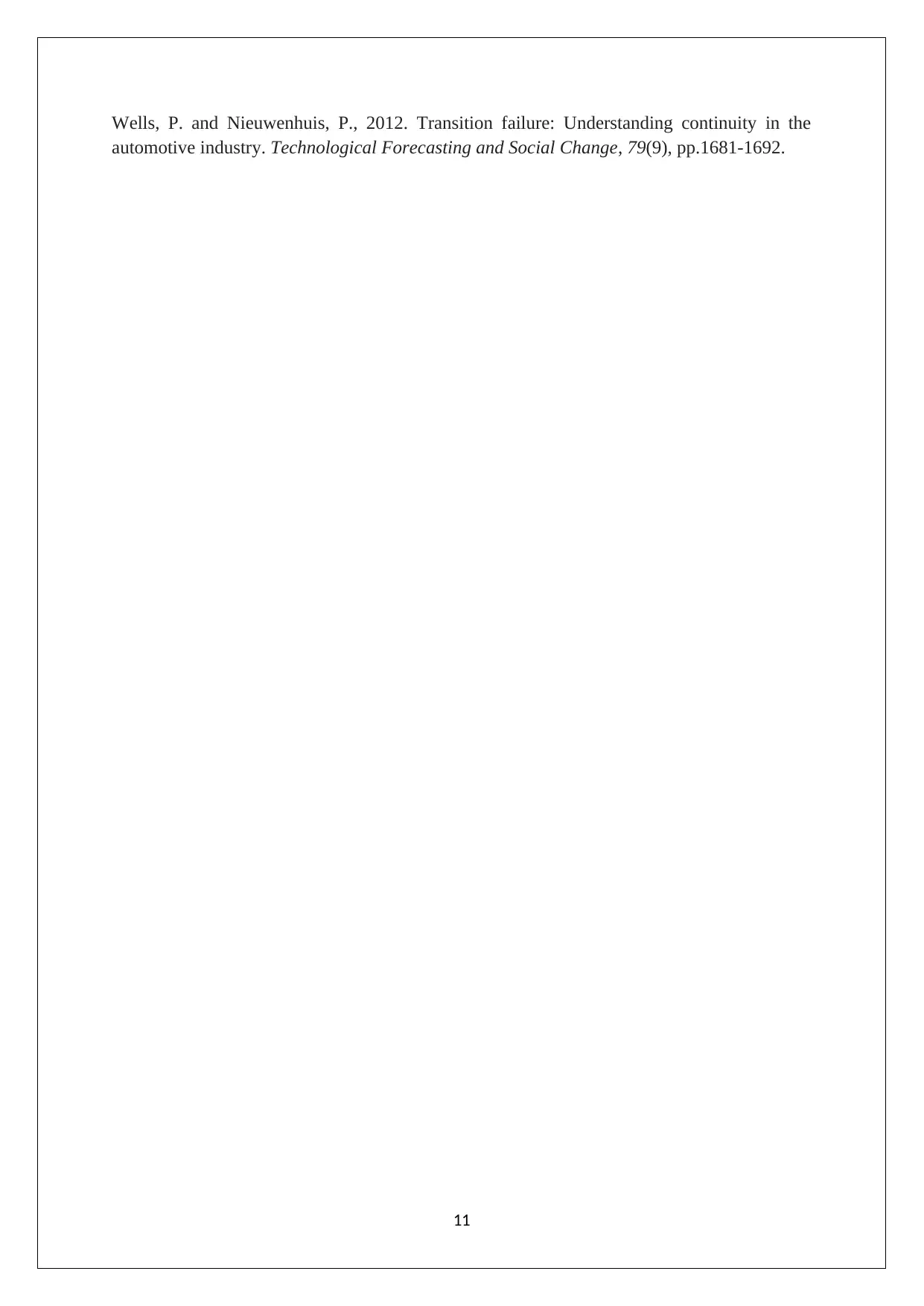
Wells, P. and Nieuwenhuis, P., 2012. Transition failure: Understanding continuity in the
automotive industry. Technological Forecasting and Social Change, 79(9), pp.1681-1692.
11
automotive industry. Technological Forecasting and Social Change, 79(9), pp.1681-1692.
11
1 out of 11
Related Documents
Your All-in-One AI-Powered Toolkit for Academic Success.
+13062052269
info@desklib.com
Available 24*7 on WhatsApp / Email
![[object Object]](/_next/static/media/star-bottom.7253800d.svg)
Unlock your academic potential
Copyright © 2020–2025 A2Z Services. All Rights Reserved. Developed and managed by ZUCOL.



